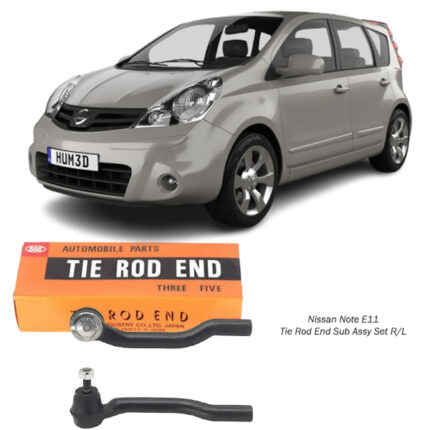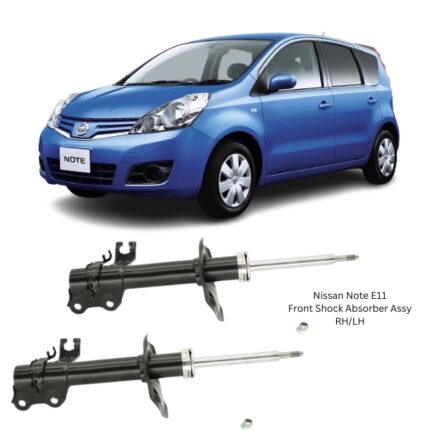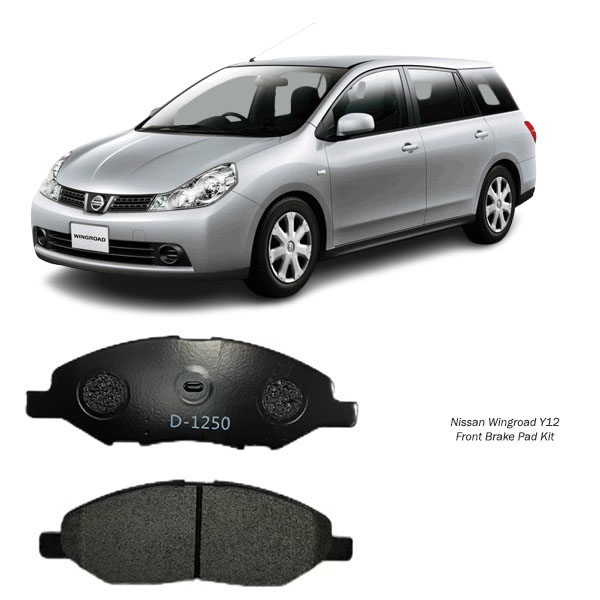-14%
Get Nissan Wingroad Y12 Front Brake Pad Kit D1250 in Kenya
In the world of automotive safety, few components play a more critical role than the Front Brake Pad Kit. These pads form the primary contact point between the braking system and the wheels, turning the kinetic energy of your vehicle into thermal energy, allowing your car to slow down or stop completely. Though relatively small and often inexpensive, front brake pads are essential to the safe operation of any vehicle. A well-functioning set not only ensures reliable stopping performance but also contributes to driver comfort, handling, and tire longevity.
What is a Front Brake Pad Kit?
A front brake pad kit typically includes two brake pads per wheel (four in total for the front axle), along with accompanying hardware such as anti-rattle clips, wear sensors, and sometimes lubricant for smoother installation and operation. These pads are fitted inside the brake caliper and press against the brake disc (rotor) when the brake pedal is engaged.
Brake pads are made of high-friction materials bonded to a metal backing plate. Their purpose is simple but vital: to create enough friction against the rotors to reduce wheel speed or bring the vehicle to a complete stop. Over time, this constant friction leads to gradual wear, which is why brake pads need regular inspection and replacement.
Types of Brake Pads
Front brake pad kits come in different materials, each with unique characteristics:
-
Semi-Metallic Pads:
These contain metal fibers (steel, iron, or copper) and are known for excellent heat dissipation and durability. They’re commonly used in everyday vehicles and offer a good balance between performance and cost. -
Ceramic Pads:
Made of dense ceramic fibers and non-metallic filler material, ceramic pads are quiet, clean (low dust), and long-lasting. They provide smooth braking but are usually more expensive and may wear rotors faster. -
Organic (Non-Asbestos Organic – NAO):
Composed of rubber, glass, and resins, organic pads are softer and quieter but wear faster and may not perform as well under high temperatures. -
Low-Metallic NAO:
A blend of organic materials with small amounts of copper or steel for better heat transfer. These provide improved braking performance compared to traditional organics but may be noisier.
Functions and Importance
The front brake pads are responsible for approximately 60–70% of a vehicle’s total braking power. This is due to weight transfer during deceleration, which places more load on the front wheels. As such, front brake pads tend to wear faster than rear pads.
Key functions include:
-
Slowing or stopping the vehicle: Converts kinetic energy into heat energy through friction.
-
Distributing braking force: Works with calipers and rotors to maintain stability while braking.
-
Controlling vehicle dynamics: Affects how the vehicle behaves under braking—especially in corners or during sudden stops.
Advantages of a Good Front Brake Pad Kit
-
Reliable Braking Performance:
Quality pads offer consistent braking response under various conditions—wet or dry, cold or hot. -
Enhanced Safety:
Strong, dependable braking reduces stopping distances and improves reaction time in emergencies. -
Noise Reduction:
Modern high-quality brake pads come with shims and anti-noise layers for quiet operation. -
Longer Rotor Life:
Well-designed pads minimize rotor wear, saving on overall brake system costs. -
Low Brake Dust:
Especially true for ceramic pads, low dust generation keeps wheels cleaner and reduces contamination. -
Thermal Stability:
Resistance to fade and high temperatures ensures performance during aggressive driving or heavy loads.
Disadvantages of a Worn or Poor-Quality Front Brake Pad Kit
-
Reduced Stopping Power:
Worn pads lose friction material, resulting in longer braking distances and lower effectiveness. -
Noisy Operation:
Cheap or worn pads may squeal, screech, or grind when braking. -
Brake Fade:
Subpar pads are more likely to overheat and lose performance under repeated braking. -
Uneven Rotor Wear:
Hard or inconsistent materials can create grooves or warping on rotors. -
Increased Maintenance Costs:
Poor-quality pads may wear out faster and lead to premature failure of rotors and calipers.
Signs of Worn Brake Pads
Monitoring your brake pad condition can prevent expensive repairs and ensure safety. Common signs include:
-
Squealing or squeaking sounds: Often caused by a wear indicator making contact with the rotor.
-
Grinding noise: This may mean the pad is completely worn, and metal is now grinding against metal.
-
Brake warning light: Some vehicles have sensors that alert when pads are thin.
-
Increased stopping distance: If your car takes longer to stop, the pads may not be generating enough friction.
-
Vibration when braking: Warped rotors from worn pads can cause pulsation through the brake pedal.
-
Visual inspection: Pads with less than 3mm of material should be replaced.
How to Install a Front Brake Pad Kit
Installing a brake pad kit requires mechanical knowledge and safety precautions. Here’s a general guide:
Tools Needed:
-
Jack and jack stands
-
Lug wrench
-
Brake caliper tool or C-clamp
-
Socket/wrench set
-
Brake cleaner
-
Torque wrench
-
New brake pads and hardware kit
Steps:
-
Lift and Secure the Vehicle:
Loosen lug nuts, lift the vehicle with a jack, and support it securely with jack stands. -
Remove the Wheel:
Fully remove the lug nuts and take off the wheel to access the brake assembly. -
Unbolt the Caliper:
Locate the caliper bolts and remove them. Carefully slide the caliper off the rotor and support it to avoid tension on the brake hose. -
Remove Old Pads:
Slide out the old brake pads. Remove any old clips or hardware. -
Install New Hardware:
Fit new anti-rattle clips or shims into the caliper bracket if provided. -
Compress the Caliper Piston:
Use a C-clamp or brake caliper tool to slowly compress the piston into the caliper housing to make room for the new pads. -
Install New Pads:
Insert the new pads into the bracket, making sure they’re seated securely. -
Reattach the Caliper:
Slide the caliper back over the pads and tighten bolts to the manufacturer’s torque specification. -
Reinstall Wheel and Lower Vehicle:
Refit the wheel and lug nuts. Lower the car and tighten the lug nuts with a torque wrench. -
Test the Brakes:
Before driving, pump the brake pedal until it feels firm to reseat the brake pads. Take a test drive to confirm proper operation.
Follow us on Facebook for more parts.




